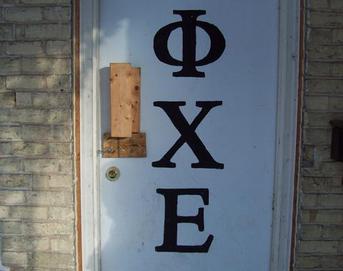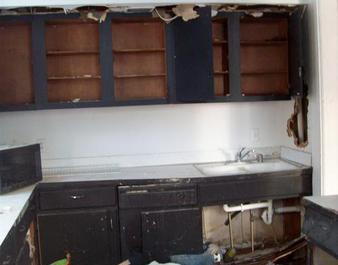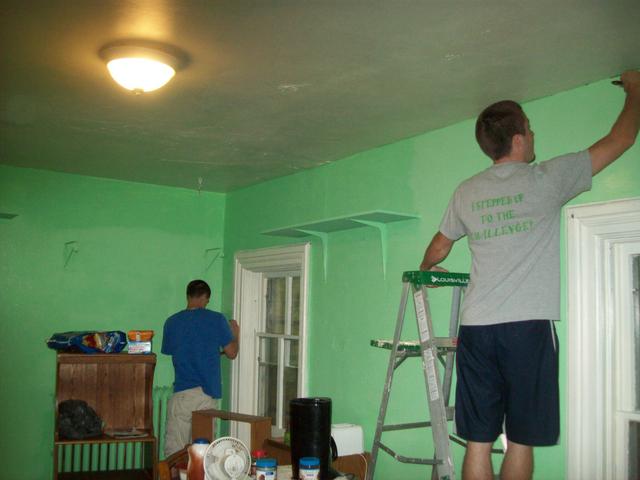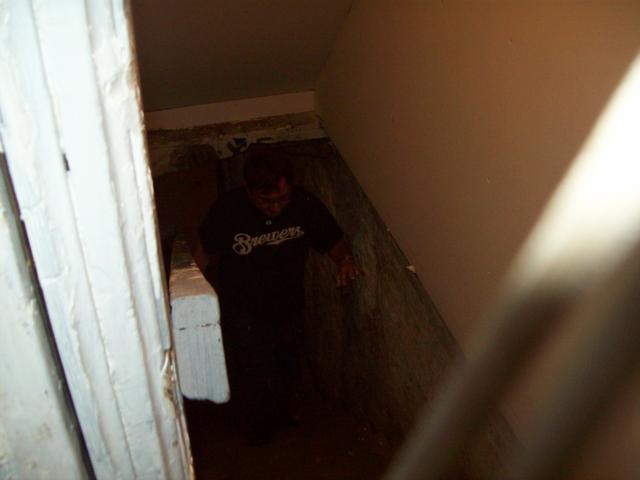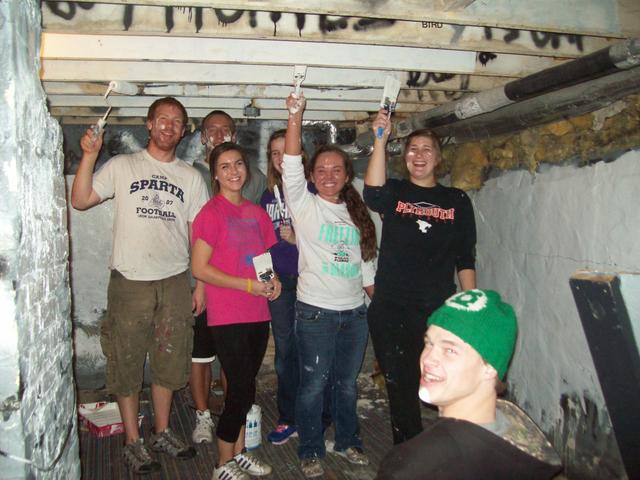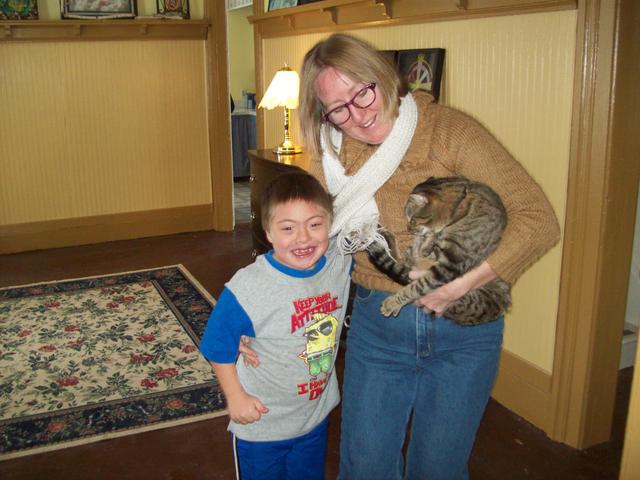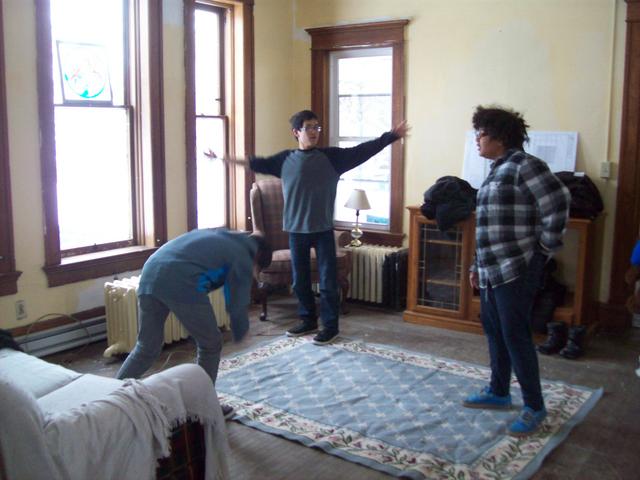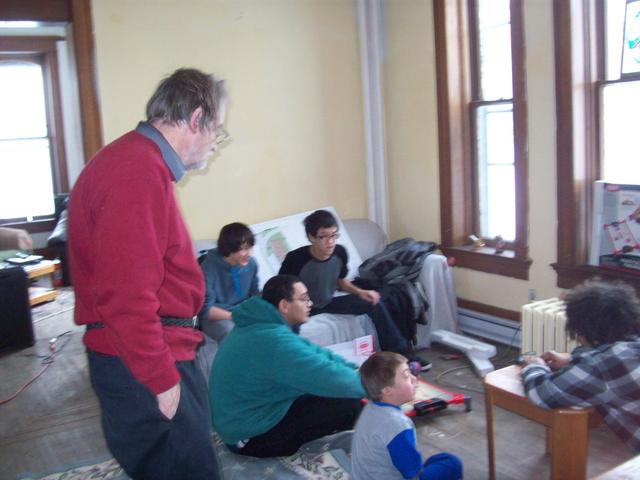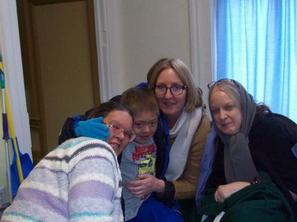Personal Transformation through House Renovation
Photos above show parts of the historic landmark house
we are renovating before we started working.
Enter your text here...
The Scary Basement
As everyone knows, there are many scary things in a basement, usually because of what people have left there. When cleaning the basement of this old house, we found for example, lots of underwear (clean and dirty), assorted shoes, a full sized bar built by the past fraternity guys, piles of ordinary dirt interspersed with beer cans and broken booze bottles, lots of broken boiler pipes, moldy furniture, hanging bare electrical wires, graffiti spray painted on the walls along with lots of phone numbers, and one enterprisingly large toad. Basements seem to be the place we put things that we don’t want to throw out or don’t want others to see us throw out.
An interesting fact about many of the basements of the 1800s houses in Whitewater is that they have tunnels to other buildings, remnants of the Underground Railroad to hide slaves escaping to the north. Although some people think these tunnels may also have been used to connect various houses to the spiritualism college that was active in Whitewater at the turn of the 1900s. The Morris Pratt Institute operated into the 1930s and has given Whitewater a continued history of mystery and produced many a ghost story. For example, this old house is considered by neighbors to be haunted although our friends who live there, have had no extrasensory experiences, not even an encounter with a mouse or a bat.
Although scary, basements, like fear, are necessary for protecting ourselves. They are needed to make a house structurally sound, and to store important things you need like food in a root cellar, along with things you want buried or forgotten. Burying and forgetting painful things can sometimes be the only way people can survive. I sometimes think digging up pain to remember it in all its horror is one of those psychological theories that go in and out of fashion and isn’t right for everyone. Maybe people were made with poor memories as a coping strategy so that some things can be buried and forgotten, like women forgetting the pain of childbirth.
Many positives and negatives of basements depend on how they are used, whether as a garbage dump or protection from the tornadoes of life. And if a basement is a metaphor for our lives, then basements need more respect and care than we often give them. They should be cleaned regularly for example, and repairs made when needed, and although they can hide scary facets of ourselves, they also hold remnants of our history that make us who we are.
For example, basements are built on footings that distribute the weight of the house across the ground to minimize settling and sinking, like a person needs to be grounded and balanced to keep from psychologically sinking or falling apart. In cold geography like Wisconsin, a basement foundation has to be below the frost line so the building does not shift in the freeze-thaw cycle, like a person’s emotions need to be placed deep enough so that they are not constantly shifting with the heat or the cold of the moment. Basements also reduce heating and cooling costs since they act as a form of earth sheltering and a way to reduce a building’s surface area-to-volume ratio. I think of earth sheltering in houses like family and friend support systems for people. It insulates you from the cold and heat extremes of life. I think of surface area-to-volume ratio as an example of detachment needed to operate in the world’s uncontrollable and unpredictable events. If too much of your surface self is exposed, you also lose control of yourself, and cannot modulate the vicissitudes of life’s variability. But detachment is a whole other topic that becomes very important when dealing with roof repairs.
The neat thing is that each person gets to pick their own kind of basement in life. Some people like daylight or “walk-out” basements where they can go in and out of their human depths more freely. Other people like “look-out” basements where the basement walls extend sufficiently above ground so that some of the basement windows are above ground level letting in the sunlight of self-awareness but not totally exposing secrets to others. Of course there are also “walk-up” basements where the basement has an exterior entrance via a stairwell which suggests easier access into a person’s heart and soul by others in the outside world, depending on whether the owners of the basement leave the door open or locked, a form of psychological control. And last, but not least, although it is least in a physical sense, is the crawl space which is the type of basement where a person can’t stand up. Crawl spaces may be as little as a foot high and have a surface that is soil. I will let you surmise what a crawl space may intimate psychologically.
And there must be some consideration to the recent development of the finished basement, sometimes referred to as the “man-cave.” This term suggests that females do not like to live in caves while males do. I’m not sure what to make of the psychological inference here, but finished basements do put a bigger emphasis on drainage considerations. If there is some water on the floor of an unfinished basement, this is less of a concern than if you have full-time living arrangements set up there where you can be breathing in constant moldy or stagnant air. Basements, like our psychological self, need good ventilation and an opportunity to air itself out otherwise our mind and views can become stagnant, smelly, and rotten. There is nothing smellier than a rotten belief.
I hope this discussion of basements has been of some benefit. Our old house basement has become much less scary as it is occupied more and more by helpful concerned friends painting over all the black walls. May we all have friends like these to take the blackness out of our life.
When Your Friend Likes Green
I hate the color green. I know it is the color of many beautiful things- grass, certain animals, some cats’ eyes, etc and is supposed to represent growth. But in my mind it is the color of all the bathrooms in every old school I have ever seen, the color of infected material, algae blooms that kill fish, certain kinds of mold, corroded metal. So when the house caretaker picked the color she wanted for her kitchenette, she picked a bright lime green. I had told her she could pick any color (except black which was the color of most of the walls in the old house we were already repainting) and she even bought the paint, so it was hard for me to go back on my word, although I did convince her to paint the ceiling and molding white.
What do we do when people we like have such different taste than us? First of all how can we be friends with people who seem in some ways to be so different? I mean, if they like green, how can we see eye-to-eye, as they say? Of course my friend has been very patient with my overwhelming preference for varying shades of white. I guess patience and acceptance must come into play with color because I now walk through the kitchenette with less notice of its color and have even considered using a muted greenish tone in the downstairs bathroom to match the retro pale green sink there. Although green, it was a perfectly good sink with working faucets in a slightly broken vanity which someone threw out and I rescued from the curb before the garbage truck arrived. I have found most of the furniture I own from various street curbs. How can people throw out perfectly fixable stuff? But that is another topic.
I suppose if we can accept other people no matter what their color preferences, we can start progressing our acceptance skills into areas like - people who wear clothes we don’t like, people who talk about things we don’t like, people who have ideas we don’t like, people who have religions we don’t like, people who look different than what we like. I guess we can learn to like the people themselves no matter what our other dislikes about them are. It’s sort of a paradox and I love paradoxes.
Paradoxes challenge all our absolutes and this helps us accept life’s changes and differences.
Thou shalt not kill - except maybe if you are protecting someone.
Thou shalt not steal – except maybe unless you are starving.
Thou shalt not lie – except maybe if it’s to save someone’s life.
So the paradox is that we can like people who don’t like what we like or maybe don’t even like us.
But I still don’t like green.
Christmas in the past at the Historic Nelson Salisbury House
What can house renovation teach you about life?




